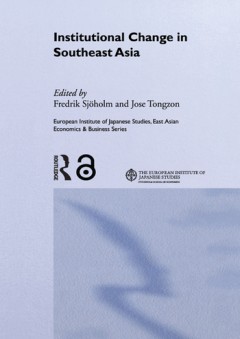Filter by

Islam on the move : the Tablighi Jama'at in Southeast Asia
Much nuance and variability have been lost in the process of the reductivist analysis of Islam post 9/11 and, as this study amply demonstrates, we are all the poorer as a result. This exhaustive examination of the rise and spread of the Tablighi Jama't, arguably the world's largest Islamic missionary movement, locates it in the larger perspective of global Islam and developments in the Muslim s…
- Edition
- -
- ISBN/ISSN
- 9789089644398
- Collation
- 255p. : ill.
- Series Title
- -
- Call Number
- 297.0959 NOO i

The Dutch and English East India Companies : diplomacy, trade and violence in…
A ground-breaking collection of essays that explores the place of the Dutch and English East India Companies in Asia and the nature of their interactions with Asian rulers, officials, merchants, soldiers and brokers. The Dutch and English East India Companies were formidable organizations that were gifted with expansive powers that allowed them to conduct diplomacy, raise armies and seize terri…
- Edition
- -
- ISBN/ISSN
- 9789462983298
- Collation
- 262p. : ill
- Series Title
- -
- Call Number
- 338.88 DUT d

Independent filmmaking across borders in contemporary Asia
Independent Filmmaking across Borders in Contemporary Asia examines an array of auteur-driven fiction and documentary independent film projects that have emerged since the turn of the millennium from East and Southeast Asia, a strand of transnational filmmaking that converges with Asia’s vibrant yet unevenly developed independent film movements amidst global neoliberalism. These projects bear…
- Edition
- -
- ISBN/ISSN
- 9789048537921
- Collation
- 278p. : ill.
- Series Title
- -
- Call Number
- 791.43095 MA i

Global digital cultures : perspectives from South Asia
Digital media histories are part of a global network, and South Asia is a key nexus in shaping the trajectory of digital media in the twenty-first century. Digital platforms like Facebook, WhatsApp, and others are deeply embedded in the daily lives of millions of people around the world, shaping how people engage with others as kin, as citizens, and as consumers. Moving away from Anglo-Americ…
- Edition
- -
- ISBN/ISSN
- 9780472131402
- Collation
- viii, 317p. : ill.
- Series Title
- -
- Call Number
- 302.2310954

Institutional change in Southeast Asia
This book examines the institutional changes taking place in, and challenges facing, the region since 1997. It also describes various differences in the reform process between countries in the region. Sjöholm and Tongzon argue that the economies of southeast Asia need to reform their institutions if the previous rapid development is to continue. The institutional weaknesses have been addressed…
- Edition
- -
- ISBN/ISSN
- 9780203694633
- Collation
- xv, 206p. : ill.
- Series Title
- -
- Call Number
- 330.959 INS

Tellings and texts: music, literature and performance in North India
- Edition
- -
- ISBN/ISSN
- 9781783741052
- Collation
- 566 p.; 23 cm.
- Series Title
- -
- Call Number
- 801.93 TEL t
- Edition
- -
- ISBN/ISSN
- 9781783741052
- Collation
- 566 p.; 23 cm.
- Series Title
- -
- Call Number
- 801.93 TEL t

Islamic area studies with geographical information systems
In this volume the contributors use Geographical Information Systems (GIS) to reassess both historic and contemporary Asian countries and traditionally Islamic areas. This highly illustrated and comprehensive work highlights how GIS can be applied to the social sciences. With its description of how to process, construct and manage geographical data the book is ideal for the non-specialist looki…
- Edition
- -
- ISBN/ISSN
- 9780203401422
- Collation
- xxvi, 283p. : ill.
- Series Title
- -
- Call Number
- 910.91767 ISL i

Persian documents : social history of Iran and Turan in the fifteenth to nine…
After the Mongol period, Persian was the official written language in Iran, Central Asia and India. A vast amount of documents relating to administration and social life were produced and yet, unlike Ottoman and Arabic documents, Persian historical resources have received very little critical attention. This book is the first to use Persian Documents as the sources of social history in Early Mo…
- Edition
- -
- ISBN/ISSN
- 9780203508862
- Collation
- xvii, 189p. : ill.
- Series Title
- -
- Call Number
- 955.03 PER p

Revolution, reform and regionalism in Southeast Asia : Cambodia, Laos and Vie…
Based on research carried out over the three decades, this book compares the post-war political economies of Cambodia, Laos and Vietnam in the context of their individual and collective impact on contemporary efforts at regional integration. The author highlights the different paths to reform taken by the three neighbours and the effect this has had on regional plans for economic development th…
- Edition
- -
- ISBN/ISSN
- 9780203099476
- Collation
- xiii, 282p. : ill.
- Series Title
- -
- Call Number
- 959.051 ST r

Engaging the neighbours : Australia and ASEAN since 1974
From modest beginnings in 1967, the Association of Southeast Asian Nations (ASEAN) has become the premier regional institution in Southeast Asia. The 10 members are pursuing cooperation to develop the ‘ASEAN Community’ and also sponsor wider dialogues that involve the major powers. Australia has been interested in ASEAN since its inauguration and was the first country to establish a multila…
- Edition
- -
- ISBN/ISSN
- 9781760460181
- Collation
- xiv, 258p. : ill.
- Series Title
- -
- Call Number
- 327.94059 FRO e
 Computer Science, Information & General Works
Computer Science, Information & General Works  Philosophy & Psychology
Philosophy & Psychology  Religion
Religion  Social Sciences
Social Sciences  Language
Language  Pure Science
Pure Science  Applied Sciences
Applied Sciences  Art & Recreation
Art & Recreation  Literature
Literature  History & Geography
History & Geography